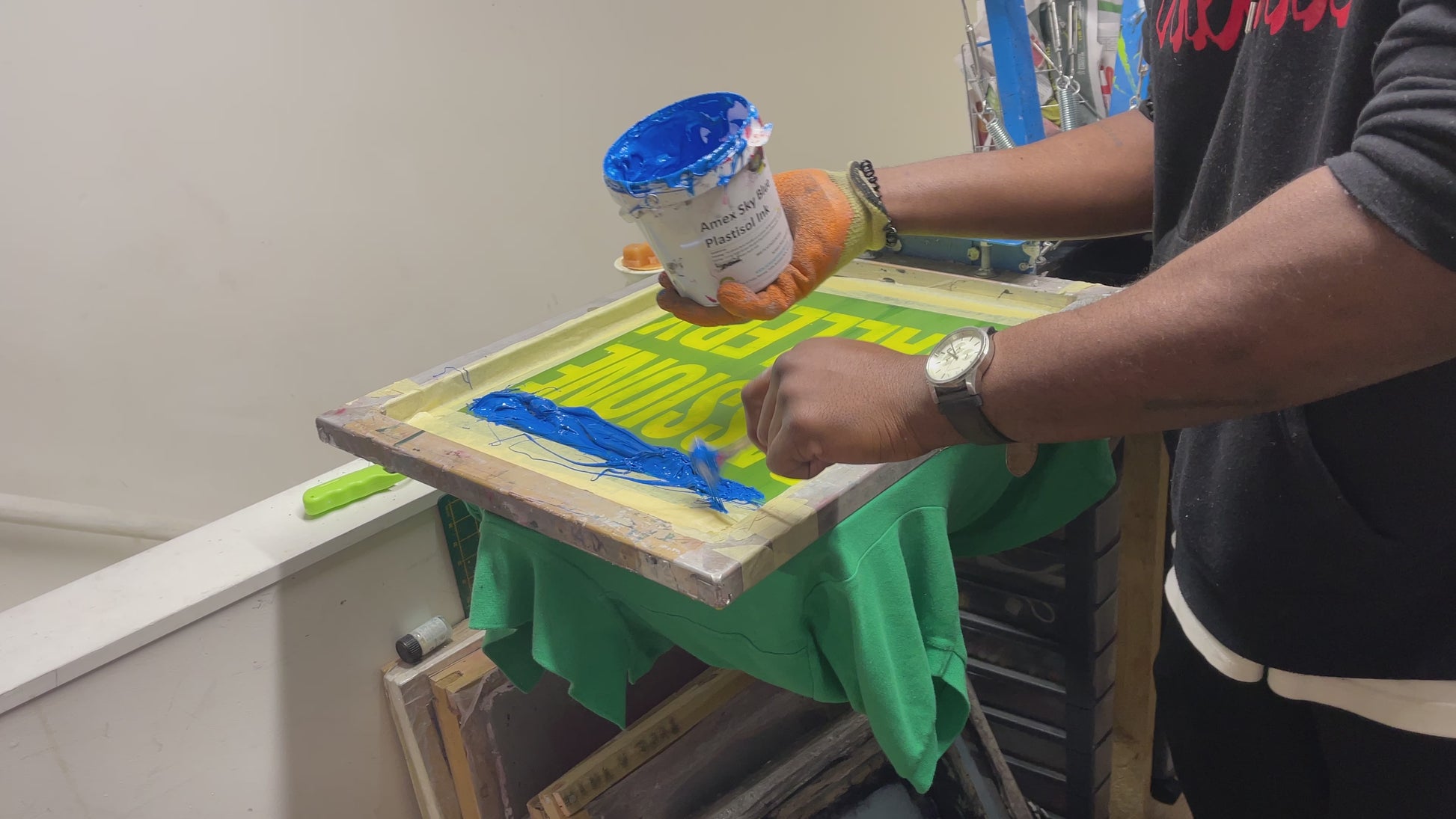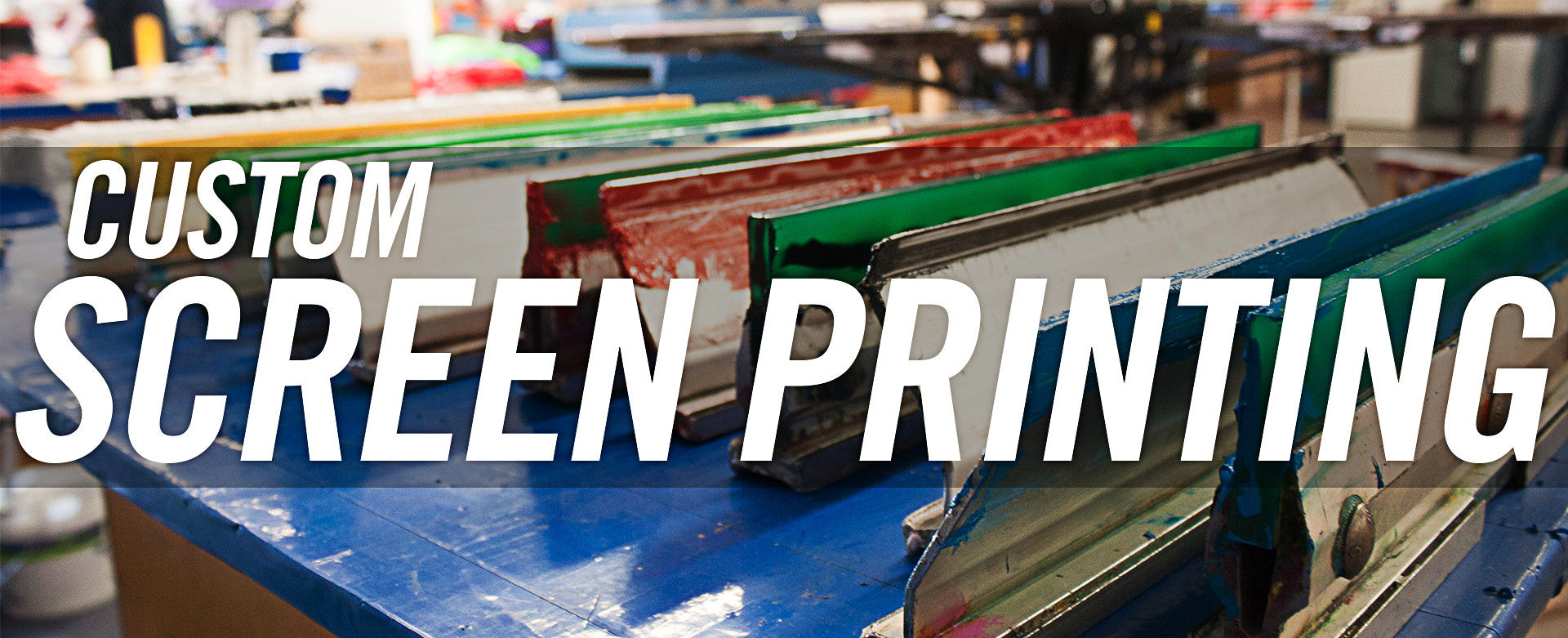Screen Printing Uncovered: Every Little Thing You Required to Know Concerning Tee Shirt and Garment Printing Techniques
Screen printing is a remarkable approach that incorporates art with method, offering unlimited possibilities for creative thinking. Ready to discover the important elements that make display printing an art type?
The Basics of Display Printing: Just How It Works
When you plunge into display printing, you'll uncover it's both an art and a science. At its core, display printing involves producing a stencil, or display, that allows ink to go through just in particular areas (screen printing kit). You start by selecting your design and preparing your screen with a light-sensitive solution. When you subject this solution to light, it hardens, leaving your style as a negative area.
Setting the display over the textile, after that make use of a squeegee to push ink through the screen onto the garment. Each step is important, and understanding them will elevate your screen printing abilities, changing basic garments right into special, expressive pieces.
Kinds Of Screen Printing Methods
As soon as you realize the essentials of display printing, it's time to check out the different methods that can boost your designs. One popular technique is typical display printing, where ink is pressed via a stenciled display. This method is excellent for bold, dynamic colors. Then there's water-based ink printing, which offers a softer feeling and is eco-friendly, however it needs a various approach to curing.
If you're aiming for great details, consider discharge printing. This strategy removes dye from the material, leaving a soft, vintage look. Another alternative is plastisol printing, known for its sturdiness and brilliant colors, making it a favored for many brand names. Experiment with halftone printing to produce gradient effects and complex layouts. Each method has its unique beauty, so don't hesitate to try them out to find what matches your design best!
Necessary Equipment for Screen Printing
To achieve spectacular lead to display printing, having the right devices is fundamental. You'll need a sturdy screen printing structure, which holds the mesh that moves your layout onto the garment. Next off, purchase top notch squeegees; these are crucial for using ink uniformly across the screen. You'll additionally need an excellent exposure device to produce your screens, in addition to a washout booth for cleaning them after use. A dependable heat resource, like a conveyor dryer or warmth press, is essential for healing your prints to guarantee longevity. Do not fail to remember a correct work area, equipped with tables and storage space for your products. Lastly, safety gear, such as masks and gloves, will maintain you safe from chemicals and inks. With the right devices, you'll be well on your method to creating professional-quality prints.
Picking the Right Inks and Products
When picking inks and products for display printing, you need to take right into account the kind of ink that works best for your project. Assume regarding fabric compatibility to ensure your layouts look last and great long. Discover green ink choices to make your printing procedure much more lasting.
Sorts Of Screen Inks
Picking the appropriate screen ink is important for attaining dynamic, sturdy prints that fulfill your task's demands. There are several kinds of screen inks to take a look at. Specialty inks, such as glow-in-the-dark or metallic, can include distinct effects to your layouts.

Fabric Compatibility Considerations
Recognizing material compatibility is essential for attaining high-quality display prints, particularly because various products react distinctly to numerous inks. Always test your inks on example textile to assure they adhere appropriately and preserve color honesty. Additionally, maintain in mind that material weight and structure can impact the final result, so picking the ideal ink and material combo is important for your task's success.
Eco-Friendly Ink Options
Green inks are becoming a prominent choice for screen printers that desire to lessen their environmental impact while maintaining top quality. When selecting inks, consider water-based inks, which are less dangerous and easier to clean up compared to standard solvents.
Furthermore, search for inks made from renewable energies, such as soy or vegetable-based options. By selecting the ideal inks and products, you'll not just produce stunning designs but also add to a more sustainable printing procedure. Make the switch, and your prints will certainly mirror your dedication to the atmosphere!
Preparing Your Design for Display Printing

File Format Requirements
To guarantee your style looks dynamic and sharp on textile, you'll need to pay very close attention to submit layout requirements for display printing. Beginning with vector documents like AI or EPS, as they can be scaled without losing top quality. If you visit homepage utilize raster images, choose high-resolution data, such as TIFF or PNG, ideally at 300 DPI. Stay clear of utilizing JPEGs, as they can shed quality when resized. Additionally, ensure your design has a clear history to protect against undesirable white sides on your prints. Maintain color settings in mind; CMYK is conventional for display printing, so convert your RGB makes accordingly - screen printing kit. By complying with these standards, you'll establish your art work up for a successful print.
Shade Splitting Up Strategies
Shade separation is an essential action in preparing your style for display printing, and understanding it can considerably improve your print quality. You'll require to damage your design right into private shades, as each color calls for a separate display throughout printing. Beginning by recognizing all the colors in your layout and develop layers for each one. You can make use of software program like Adobe Photoshop or Illustrator to isolate and separate colors successfully. Be certain to conserve each layer as a separate documents, normally in a format like TIFF or PSD. This precision not just assures precise shade representation yet additionally simplifies the printing process. By taking notice of shade separation, you'll achieve vibrant and specialist cause your screen-printed garments.
Resolution and Dimension
Attaining the most effective lead to display printing starts with guaranteeing your style has the right resolution and size. Preferably, your art work ought to be at the very least 300 DPI (dots per inch) for sharp, clear prints. Your last item might look amateur and pixelated. if you utilize lower resolution.
When it involves dimension, take into consideration the dimensions of your print location. Style your art work to match the last print dimension, preferably creating it in the actual measurements you'll be publishing. In this manner, you'll stay clear of any kind of unanticipated scaling problems.
Always check your design in both vector and raster layouts. Vector graphics can be scaled without losing quality, making them suitable for display printing. Preparing properly will ensure your design looks fantastic on every garment!
Step-by-Step Screen Printing Process
Screen printing is a vibrant procedure that permits you to create vibrant styles on numerous surfaces. To get going, you'll require a display, emulsion, and your chosen ink. First, prepare your display by cleaning it thoroughly. Next, apply the emulsion evenly and let it dry in a dark location. As soon as completely dry, expose your display to light with your layout put on it, which will solidify the solution where the light hits, creating a pattern - screen printing kit.
After cleaning out the unexposed solution, your display prepares. Set it up on your printing surface area and align your garment underneath it. Put ink onto useful reference the screen and utilize a squeegee to press the ink through the pattern onto the fabric. Lift the screen meticulously and let the print dry. Cure the ink utilizing warmth to assure toughness. That's it! You've efficiently screen published your layout.
Tips for Successful Display Printing Projects
While you're diving into your display printing jobs, keep in mind that preparation is crucial to success. Beginning by gathering all your products-- inks, garments, squeegees, and screens. A tidy work space helps protect against unwanted errors, so clean up prior to you start.
Next, confirm your artwork is high-resolution and appropriately sized for your garment. Check your display for correct direct exposure and tidy it thoroughly to prevent spots. When mixing your inks, follow the maker's standards to attain the appropriate uniformity.
During printing, use even stress with your squeegee for consistent results. Do not rush; take your time to confirm each print fulfills your criteria. After printing, allow your garments dry entirely before handling or packaging them.
Finally, constantly keep an example of your job for future recommendation. In this manner, you can examine your progression and boost your strategies with time. Happy printing!

Often Asked Inquiries
How much time Does It Take to Establish a Screen Printing Job?
Establishing a display printing work commonly takes about 30 minutes to an hour. You'll prepare the screens, mix inks, and readjust journalism. The time differs based upon intricacy and experience, so remain arranged!
Can I Publish on Various Fabric Types Using the Same Technique?
Yes, you can publish on various fabric types utilizing the exact same method, but you'll require to adjust your inks and setups. Some textiles soak up ink in different ways, so experimenting warranties the most effective results for every product.
What Prevail Errors to Prevent in Screen Printing?
When display printing, prevent common mistakes like using the wrong ink, disregarding correct exposure times, or skipping pre-press checks. Constantly check your configuration and keep clean screens to ensure top quality results each time.
How Can I Properly Clean and Preserve My Display Printing Devices?
To properly clean and preserve your screen printing devices, you need to frequently clean displays with proper read the full info here solvents, inspect mops for wear, and guarantee all tools are saved dry and dust-free. Uniformity prevents pricey repair work and improves efficiency.
Is Screen Printing Environmentally Friendly Contrasted to Various Other Techniques?
Screen printing can be more eco-friendly than other techniques, specifically if you utilize water-based inks and eco-conscious materials. By choosing lasting supplies and techniques, you decrease waste and reduce your effect on the world.
Display Printing Uncovered: Everything You Need to Know Concerning Tee Shirt and Garment Printing Strategies
At its core, screen printing includes developing a stencil, or screen, that allows ink to pass with just in particular locations. Setting the display over the fabric, after that make use of a squeegee to press ink via the screen onto the garment. One preferred approach is standard display printing, where ink is pressed with a stenciled display.When picking inks and products for display printing, you need to take right into account the type of ink that works ideal for your job.